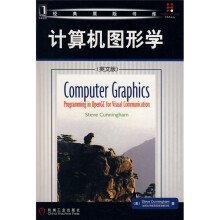计算机图形学
作者:(美)坎宁安 著
出版:机械工业出版社 2008.5
丛书:经典原版书库
页数:532
定价:36.00 元
ISBN-13:9787111239161
ISBN-10:7111239164
去豆瓣看看 Preface
Chapter 0: Getting Started
Visual Communication and Computer Graphics
General Concepts in Visual Communication
Use Appropriate Representation for Your Information
Keep Your Images Focused
Use Appropriate Presentation Levels for Your Information
Use Appropriate Forms for Your Information
Be Very Careful to be Accurate with Your Display
Understand and Respect the Cultural Context of Your Audience
Make Your Interactions Reflect Familiar and Comfortable
Relationships Between Action and Effect
3D Geometry and the Geometry Pipeline
The Scene and the View
3D Model Coordinate Systems
3D World Coordinate System
3D Eye Coordinate System
Projections
Clipping
Choosing Perspective or Orthographic Projections
2D Eye Coordinates
2D Screen Coordinates
Appearance
Color
Textures
Depth Buffering
The Viewing Process
Different Implementation, Same Result
Graphics Cards
A Basic OpenGL Program
The Structure of the Mai n O Function on OpenGL
Model Space
Modeling Transformation
3D World Space
Viewing Transformation
3D Eye Space
Projections
2D Eye Space
2D Screen Space
The Science in the Program
Appearance
Another Way to See the Program
OpenGL Extensions
Summary
OpenGL Glossary for the Chapter
Questions
Exercises
Experiments
Chapter 1: Viewing and Projection
Introduction
Fundamental Model of Viewing
Definitions
Setting Up the Viewing Environment
Defining the Projection
View Volumes
The Orthographic Projection
The Perspective Projection
Calculating the Perspective Projection
Clipping on the View Volume
Defining the Window and Viewport
Some Aspects of Managing the View
Hidden Surfaces
Double Buffering
Stereo Viewing
Viewing and Visual Communication
Implementation of Viewing and Proiection in OpenGL
Defining a Window and Viewport
Reshaping the Window
Defining a Viewing Environment
Defining a Perspective Projection
……
Chapter 2: Principles of Modeling
Chapter 3: Implementing Modeling in OpenGL
Chapter 4: Mathematics for Modeling
ChaDter 5: Color and Blending
Chapter 6: Lighting and Shading
Chapter 7: Events and Interactive Programming
Chapter 8: Texture Mapping
Chapter 9: Graphical Problem Solving in Science
Chapter 10: Rendering and the Rendering Pipeline
Chapter 11: Dynamics and Animation
Chapter 12: High-Performance Graphics Techniques
Chapter 13: Interpolation and Spline Modeling
ChaDter 14: Nonpolygon Graphics
Chapter 15: Hardcopy
References and Resources
Appendix
Index
Steve Cunningham美国加州大学斯坦尼斯洛斯分校计算机系资深教授,长期从事计算机图形学教学和研究工作。他对计算机图形学理论和OperIGL编程均有很深的造诣,曾经担任ACM SIGGRAPH学会的主席和Eurographics学会教育委员会的主任,多次组织计算机图形学和可视化教学研讨会。
本书系统地介绍了交互式计算机图形学的基础知识和OpenGL图形接口,并通过大量的实例来帮助读者理解OpenGL提供的功能。OperiGL作为一个性能优越的图形应用程序设计接口(API),适用于广泛的计算机环境,它已成为目前的三维图形开发标准,是从事三维图形开发工作的技术人员所必须掌握的开发工具。
本书将算法与应用结合起来,不过分强调计算机图形学领域内的算法与技术细节,也不专注于图像生成应用,而是将图形学视为对图像内容中的几何、外观和表示等属性编程并将编程结果展示在图形输出与交互设备上来生成合成图像的一种科学与艺术。
本书按照计算机图形学的传统顺序——投影处理、视图变换、建模、绘制、光照.明暗处理等来组织内容,并将这些要素都纳入场景图之中。同时,还强调了图形处理流水线。除了基本的图像处理技术,本书还介绍了如何利用计算机图形学来解决实际问题,以及如何更有效地将结果展示给观察者的方法。
比价列表

 缺书网
缺书网 扫码进群
扫码进群





